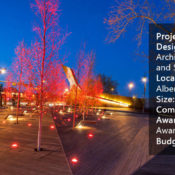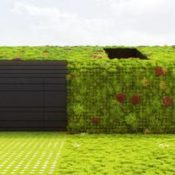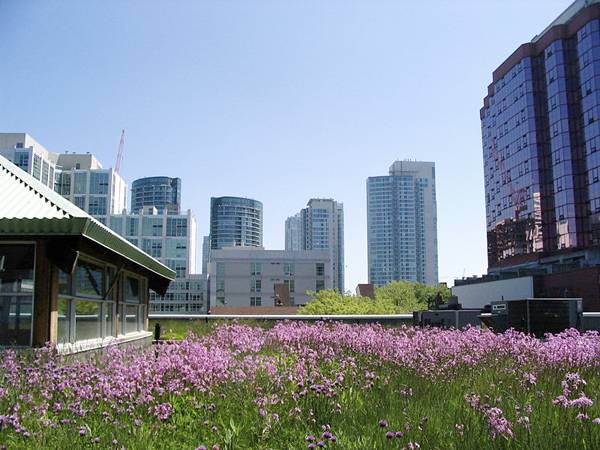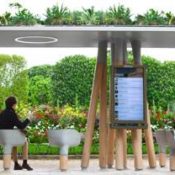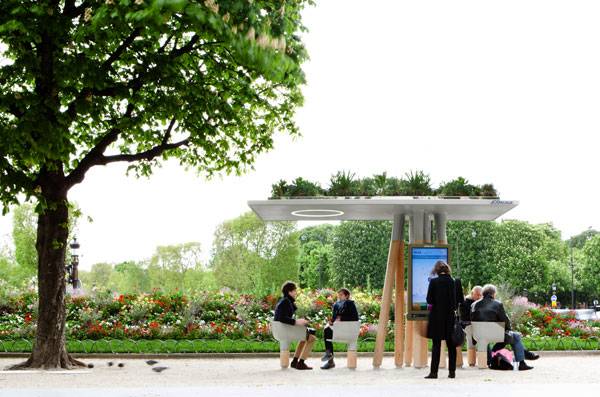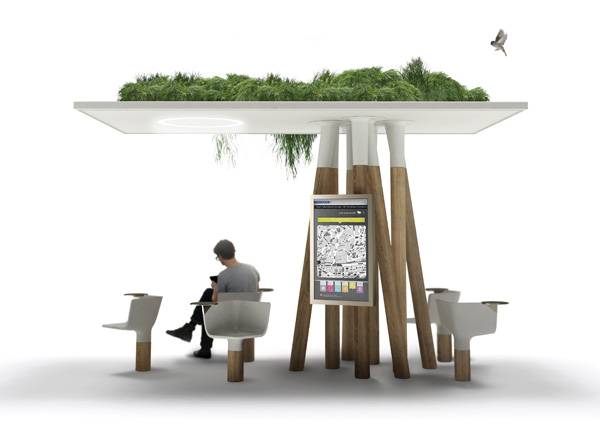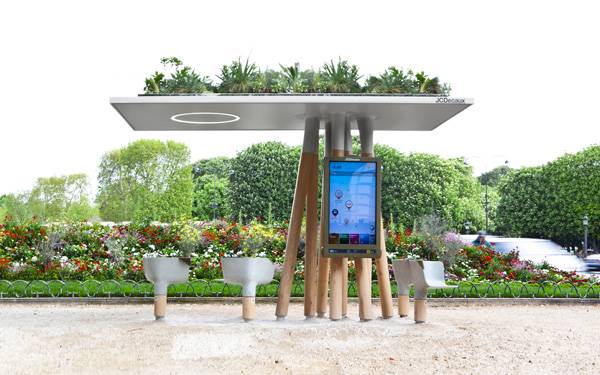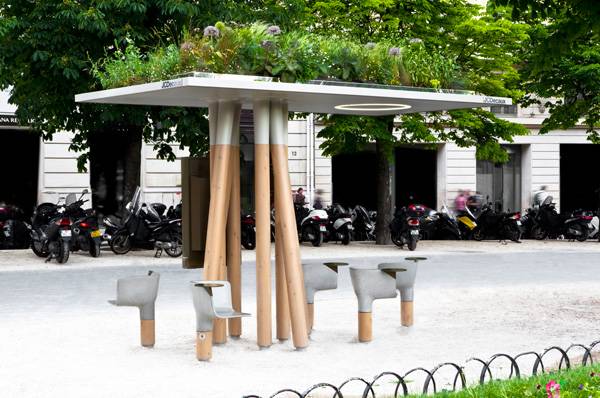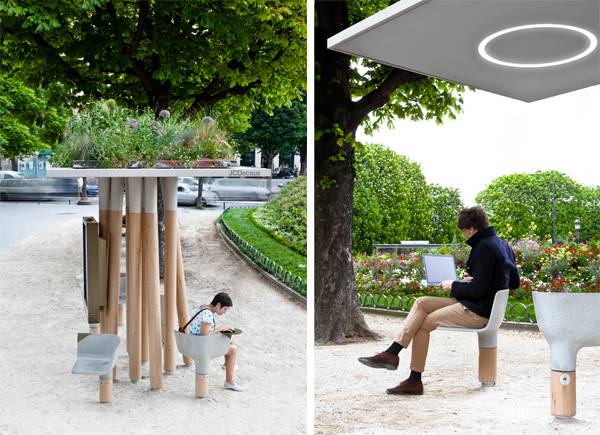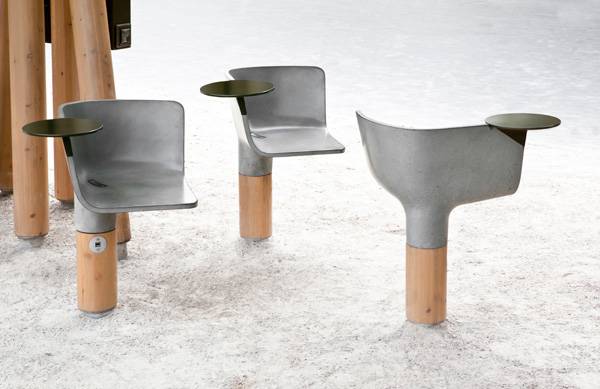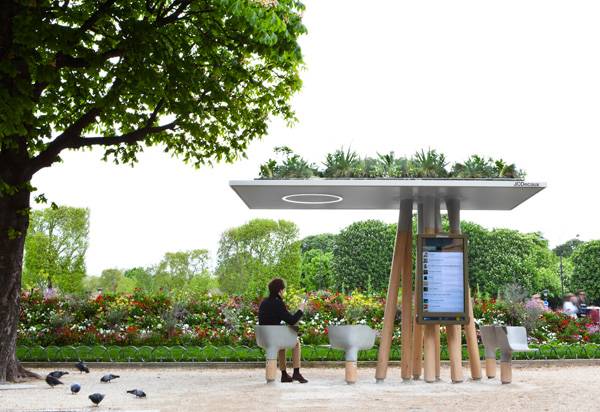Author: John Denise
Poppy Plaza: The Landscape of Memory
Poppy Plaza by Marc Boutin Architectural Collaborative and Stantec Consulting, Calgary, Alberta, Canada Like many landscapes, Poppy Plaza in Calgary, Alberta, Canada, is situated in an area that provides many opportunities we need to identify and take advantage of as designers. The inherent value in natural systems, existing development, and human use create a set of parameters that distinguishes one site from another. The way we use this information to create a thorough design that serves the needs of potential users can lead to compelling projects that make a statement. One important aspect of our communities is the connections they create. Poppy Plaza uses design to bridge old connections and create new ones. We will explore the connections Poppy Plaza makes in relation to the Landscape of Memory and surrounding areas.
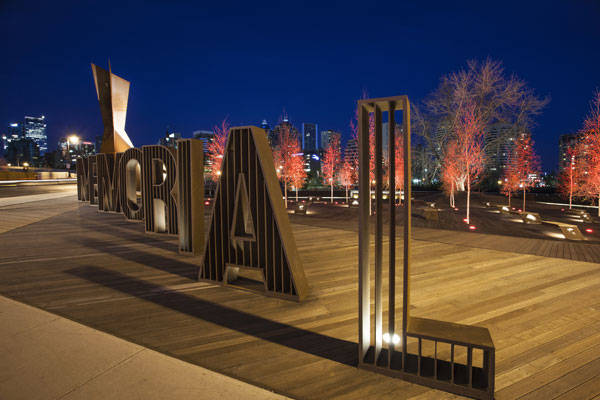
Poppy Plaza by Marc Boutin Architectural Collaborative and Stantec Consulting, Calgary, Canada
Poppy Plaza: The Landscape of Memory
Poppy Plaza is part of a $3.5 million redevelopment project along Memorial Drive known as the Landscape of Memory. The goal of the Landscape of Memory is to commemorate Canada’s contribution to World War I and II and other peace-keeping efforts. The road serves as a living memorial to the community. Designed by Marc Boutin Architectural Collaborative and Stantec Consulting, Poppy Plaza took an unused open space at the intersection of Memorial Drive and 10th Street NW and transformed it into an exciting public space.
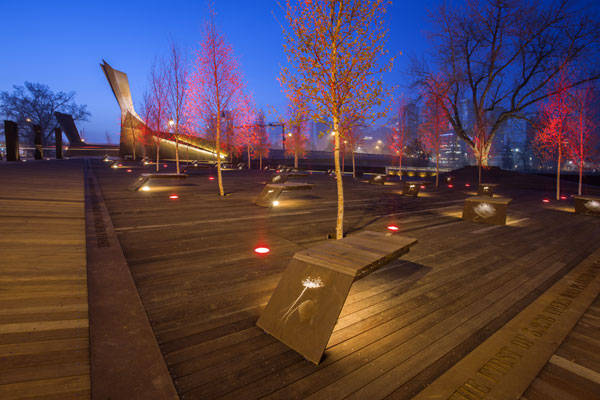
Poppy Plaza by Marc Boutin Architectural Collaborative and Stantec Consulting, Calgary, Canada
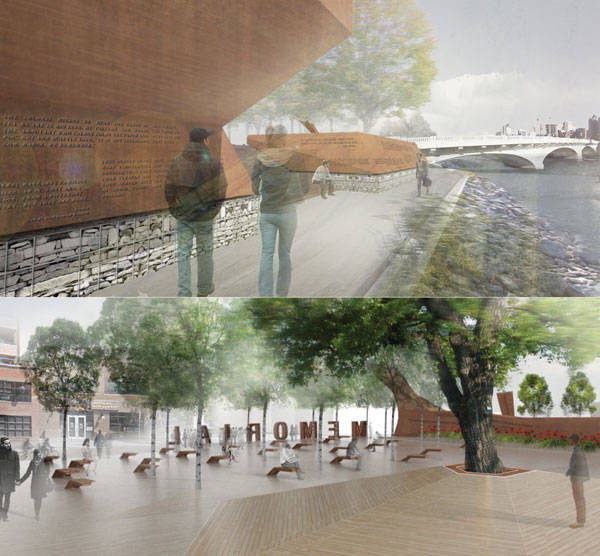
Poppy Plaza by Marc Boutin Architectural Collaborative and Stantec Consulting, Calgary, Canada
- Top Ten Most Controversial Monuments of the World
- Amazing Kinetic Sculptures That Could Hypnotize You
- The Art and Science of Wind Propelled Sculptures
Poppy Plaza: Elements to Memorialize
Using landscape as a memorial can be a powerful experience. We are so small compared to the rest of the world, and realizing this can evoke a sense of reflection. Large letters spell out “MEMORIAL” along Memorial Drive NW. These steel letters are slotted so that when you drive or walk by the site, some of the letters appear solid, while others are transparent. They have a profound presence, and blatantly spell out what the park is about.
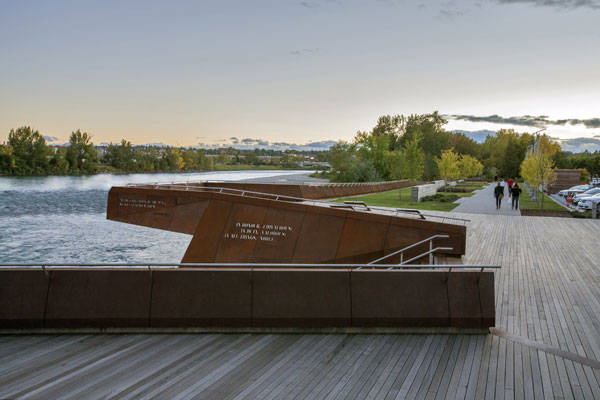
Poppy Plaza by Marc Boutin Architectural Collaborative and Stantec Consulting, Calgary, Canada
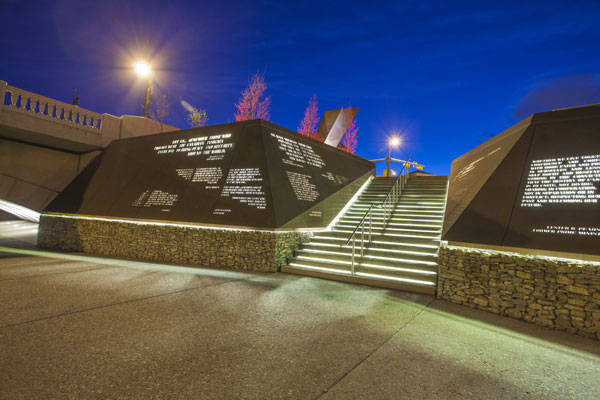
Poppy Plaza by Marc Boutin Architectural Collaborative and Stantec Consulting, Calgary, Canada
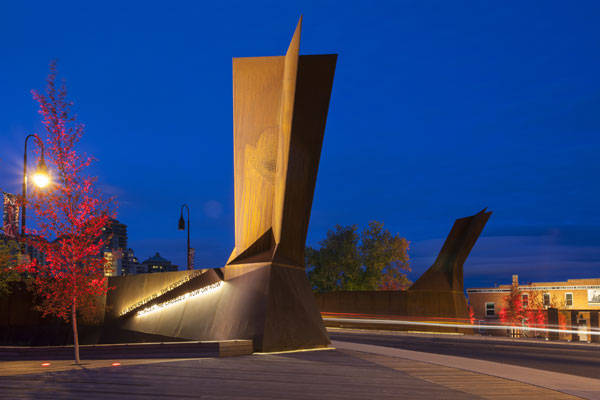
Poppy Plaza by Marc Boutin Architectural Collaborative and Stantec Consulting, Calgary, Canada

Poppy Plaza by Marc Boutin Architectural Collaborative and Stantec Consulting, Calgary, Canada
- The Green Roof Manual: A Professional Guide to Design, Installation, and Maintenance by Linda McIntyre
- Green Roof Construction and Maintenance (GreenSource Books) (McGraw-Hill’s Greensource) by Kelly Luckett
Article by Nick Shannon Return to Homepage
WARNING: Why You’re Losing Money By Not Using a Green Roof
A look at how the green roof can have a positive influence on your bank balance. In the world today, it seems like everyone is talking about how we should become more “sustainable”. With the pressing issues of climate change and in an attempt to treat the Earth in a more respectful manner, people have implemented green infrastructure into the fields of design and construction. One of the most compelling ways that we have been making buildings more environmentally friendly is through green roofs. An otherwise unused part of a building can become a functional addition that can save you money in the long run. There are several cost-saving advantages to having a green roof that can increase the efficiency of your roof.
Benefits of having a Green Roof
1. Reduced Energy Use [contextly_sidebar id=”vCfk5fd7xwUzLiaLGdD05l86NSzttKzp”] Green roofs can greatly reduce your energy bills. The plants on a green roof absorb heat and act as insulators, keeping buildings cooler in the summer and warmer in the winter. This decreases air conditioning and heating costs, which have a tendency to become expensive fast. Cooling costs can be cut by 20 to 30 percent in the summer months because the temperature of the roof is reduced. (Environmental News Network) During the winter, a green roof can lead to a 10 percent reduction in building energy use by reducing the need for heating. (ASLA) The added benefit of reducing your energy bill can become one of the reasons you should consider a green roof. 2. Green Roofs Deteriorate Slower than Conventional Roofs A green roof should be viewed as an investment in the long-term life of a building. While the upfront costs may seem troubling, the long-term benefits outweigh any short-term discomfort. The longevity of a roof greatly increases if a green roof is used instead of conventional roofing methods. WATCH: Weighing the Benefits of Green Roofs The vegetation and soil of a green roof add a layer of protection that keeps the roofing materials from deteriorating as fast as a normal roof, which would be exposed to the elements. This layer of vegetation also protects the roof from harmful UV radiation, as well as temperature extremes, reducing stress on the roofing and using the plants as a buffer. This can extend the useful life of a roof by 20 years and avoid or delay replacement costs (NRDC). 3. Increased Stormwater Management Efficiency The way, we deal with water in the built environment, is always a concerning issue. In cities, the high amount of impermeable surface inhibits the infiltration of water into the ground. This has led to the implementation of green infrastructure that can improve the efficiency of stormwater management.
Green roofs are a great alternative that mitigate the impacts of stormwater. This is accomplished by slowing the flow of the water and reducing the amount that runs off into the urban environment. A lot of money can be put into the installation of drainage systems along roofs, but the need for this is lessened with a green roof because the water is absorbed by the plants and soil. WATCH: Green Roof Grows Environmental Benefits Green roofs absorb a large amount of rainfall, ranging from 40 to 80 percent of the annual rainfall. (NRDC) This saves you money by reducing the need for drainage systems and helps the environment by dealing with water in a more natural manner. 4. Increased Property Value Green roofs are a great way to put otherwise dormant space to use and turn a roof into something that is an asset to your building. Larger buildings can accommodate green roofs with places for people to gather and experience a different perspective of the urban landscape. The need for green space in cities is an issue that can be solved with green roofs. People like to be outdoors in green space; it is beneficial for the health of the user and for the health of the environment, especially in urban areas. This can become a selling point for future buyers, along with the fact that a green roof will reduce their annual energy usage. 5. Makes your Company Look Better When a company installs a green roof, they are making a statement. It says, “We walk the walk” and shows potential customers that its values are actually being implemented in the real world. This increases customers’ trust and gives them a better feeling as to what a company is really about. WATCH: Green Roofs for Healthy Cities One company, that is starting to use its roof to its advantage, is Whole Foods. On top of its store in Lynnfield, Massachusetts, Whole Foods has created a rooftop farm to grow produce that is directly sold to customers in the store below. This is a great way, to promote the company’s image and show customers how committed the company, is to providing them with the highest quality produce possible. Bonus Video: Best Green Roofs in NYC Green roofs are a great investment that can add value to any building. With all of their money-saving benefits, green roofs can become a great asset to a company or residence. Over a 40-year period, the cost of an extensive green roof can be 20 to 25 percent less than the cost of a conventional roof (NRDC). This does not include the energy savings a green roof will provide, which will only add to your savings. If you are trying to decide if a green roof is right for you, Portland State University has a Green Roof Energy Calculator that will estimate the amount of money you save. With all of these benefits, how can we make green roofs more prominent in our cities? Recommended Reading:- The Green Roof Manual: A Professional Guide to Design, Installation, and Maintenance by Linda McIntyre
- Green Roof Construction and Maintenance (GreenSource Books) (McGraw-Hill’s Greensource) by Kelly Luckett
Article by Nick Shannon Return to Homepage
The Urban Matrix: How Far Should We Go?
Escale Numérique, by JCDecaux and Mathieu Lehanneur, Paris, France. The city of Paris aimed to increase the function of its urban infrastructure in 2012 when city officials held a competition to design intelligent street furniture. The need to integrate technology into the urban context is imminent for many cities, and this has led to a variety of design solutions. The winner of this competition was the world-leading outdoor advertising company JCDecaux, in collaboration with designer Mathieu Lehanneur. Their project, Escale Numérique (Digital Break), creates a series of WiFi stations where people can access information about the city and connect to the Internet.
Smart Urban Furniture
This urban development project is designed to create a space for people to use the Internet. A shade structure is created from a plant-covered roof supported by architectural elements that resemble tree trunks. Concrete swivel chairs are anchored underneath this roof, with a table and outlets for each person. WATCH: Escale Numérique, it’s in French but the idea speaks for itself Questioning the Connection The implementation of this project raises several questions about the function of urban infrastructure. Do we really need to be connected to the internet at all times? The urban aspect of the city is so diverse, with so many opportunities for interaction. Shouldn’t we build upon this instead of making it so easy for people to ignore their surroundings?
A Connected Haven of Peace Located on the Rond Point des Champs-Elysées, Escale Numérique provides a sense of respite from the buzz of traffic and pedestrian movement within the city. People can sit and focus on something, whether that may be their smart phone, laptop, or a book. The protective shelter of the roof and the access to free WiFi give people a feeling of separation from their surroundings. The access to the Internet is a revival of the underground fiber optic network that supplies the capital. These stations raise this connection from beneath the ground and make it accessible to the public. This idea is similar to the way the Wallace Fountains brought drinking water to Parisians in the late 1800s — the drinking water that was circulating beneath their feet became directly accessible to the public in the same way the Internet cable network is being brought up for public use. An integration of the digital and physical landscapes allows users to be productive within the city in a world in which we are increasingly dependent on technology. The Need to Be Connected We are so reliant on technology today that when we don’t have instant access to it, we become frustrated. Not so long ago, the only way people could interact was through face-to-face conversations. They got things done without the ease of computers or smart phones. The rapid development of technology in recent years has created a new paradigm of interaction and productivity. So much of our world now depends on the Internet, and our lives are now stored in the cloud or on our hard drives. It is simply how we get things done in this age of modernization. The benefits of technology, such as increased efficiency and access to information, are not without the negative effects of decreased social interaction and disconnection from the natural world. Is Avoiding Feeling Uncomfortable a Good Thing? Escale Numérique provides a connection for Parisians and tourists; however, they do not interact with each other. The large touch screen billboard is designed to be used to find your way around the city and create an augmented reality. This was done in response to the feeling of hesitation a tourist feels when he has to ask a local for directions. Related Articles:- Pavegen: Using the Pavement to Generate Energy
- Will These Solar Roadways Change The World?
- 10 Great Apps for Landscape Architects – Part 1
- Happy City: Transforming Our Lives Through Urban Design by Charles Montgomery
- The Death and Life of Great American Cities by Jane Jacobs
Article by Nick Shannon Return to Homepage
- 1
- 2


